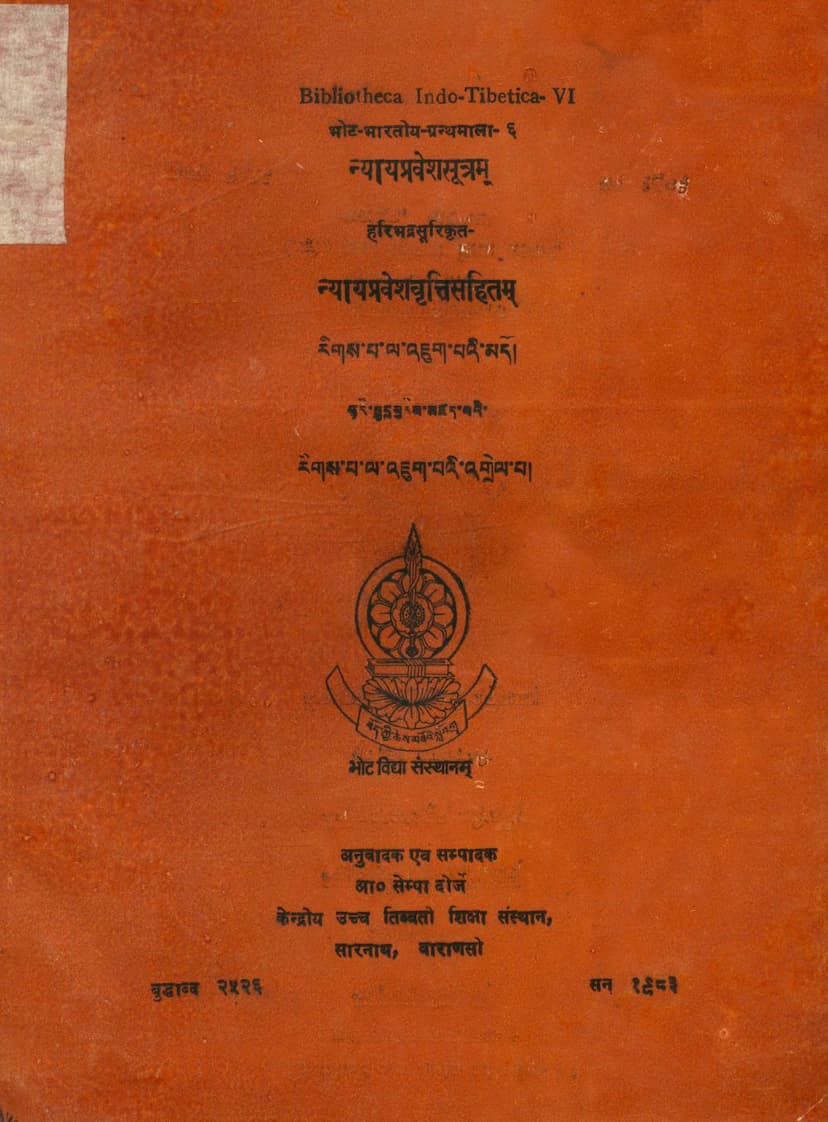Nyaypraveshsutram Nyaypraveshvrutti Sahitam
Added to library: September 2, 2025

Summary
This document is the Tibetan translation and commentary on the Nyayapravesha, a seminal work on Buddhist logic and epistemology, originally composed by the great Indian Buddhist logician Dignāga and commented upon by Haribhadrasūri. The title, Nyayapraveshsutram Nyaypraveshvrutti Sahitam, translates to "Nyayapravesha Sutra with the Commentary of Nyayapravesha". The work is published by the Kendriya Uccha Tibbati Shiksha Samsthan (Central Institute of Higher Tibetan Studies) and the catalog link provided is https://jainqq.org/explore/004342/1. The publication date is given as Buddha era 2526 (corresponding to 1982-1983 CE) and the location is Varanasi. The translator and editor is Aa Sempa Dorje.
Key Aspects and Content Summary based on the provided text:
The document appears to be a scholarly edition intended for academic and personal study, as indicated by the preface and table of contents. The text includes:
-
Tibetan and Sanskrit Titles: The title is presented in both Tibetan script (རིགས་བུ་ལ་འཇུག་པའི་མད། ནར་བླགྱུརཐ་མཛད་བའི་ རིགས་བ་ལ་འཇུག་པའི་འགྲེལ་བ།) and Devanagari script (Nyayapraveshsutram Nyaypraveshvrutti Sahitam).
-
Publisher and Translator Information: It clearly states the publisher as the Central Institute of Higher Tibetan Studies, Sarnath, Varanasi, and the translator/editor as Ma. Sempa Dorje.
-
Table of Contents (Subject Index): This is a crucial part, outlining the structure and content of the work. It lists numerous topics related to logic, epistemology, and philosophical debate, indicating a comprehensive treatment of the subject. Some key sections include:
- Preamble/Foreword (प्रकाशकीय/དཔར་སྐྲུན་བཞི་ཆེད་བརྗོད།): Likely introducing the book and its significance.
- Collection of Verses (संग्रह-श्लोकाः/ संग्रह-श्लोकाः): Introductory verses.
- Classification of Logical Terms: Such as hetu (reason), sapaksha (similar case), vipaksha (dissimilar case), drishtanta (example).
- Types of Logical Fallacies (हेत्वाभासः/ हेत्वाभासः): Such as pakshabhasa, hetvabhasa, drishtantabhasa, sadhana (proof), vaidhurya (refutation).
- Theory of Valid Cognition (प्रमाणनिरूपणम्/ प्रमाणनिरूपणम्): Discussing pratyaksha (perception) and anumana (inference).
- Detailed analysis of logical arguments and their components.
- Discussions on fallacies and refutations (दूषणनिरूपणम्/ दूषणनिरूपणम्, दूषणाभासनिरूपणम्/ दूषणाभासनिरूपणम्).
-
Commentary Sections (वृत्तिः/वृत्तिः): These sections indicate that the text includes the original Nyayapravesha Sutra (likely in Sanskrit as the root text, though the presented edition is in Tibetan with Sanskrit terms and explanations) along with Haribhadrasūri's commentary, also translated into Tibetan.
-
Introduction to Buddhist Logic and Dignāga: The preamble (प्रकाशकीय/དཔར་སྐྲུན་བཞི་ཆེད་བརྗོད།) highlights the importance of Acharya Dignāga's Nyayapravesha for studying Buddhist logic, especially for beginners. It notes that while Tibetan translations from Sanskrit and Chinese existed, they contained errors. It also mentions that some Tibetan scholars confused Nyayapravesha with Nyaymukha and that a precise Indian commentary was not previously available in Tibetan, causing difficulties. Acharya Sempa Dorje's work in revising Tibetan translations against the Sanskrit original and translating Haribhadrasūri's commentary is praised as a significant contribution. The text emphasizes the revival of the translation tradition from Sanskrit to Tibetan after centuries of interruption.
-
Historical Context of Logic: The introductory material delves into the history of logical systems, the development of Indian philosophical schools (darshanas), and the influence of Buddhism, particularly Dignāga's analytical methods. It discusses the origins of the Upaniṣads and the Vedic traditions, and later Buddhist philosophical trends.
-
Authorship and Titles: The text addresses the confusion surrounding the title, specifically differentiating Nyayapravesha (རིགས་པ་ལ་འཇུག་པ་) from Nyayamukha (རིགས་སྒོ་), which is attributed to others.
-
Detailed Explanation of Logical Concepts: The bulk of the text, as indicated by the table of contents and the numerous sub-sections, goes into a detailed exposition of logical terms, fallacies, and the structure of valid arguments. It likely follows the systematic approach characteristic of Dignāga's work, breaking down complex concepts into their constituent parts.
-
Focus on "Nyaya" (Logic): The core of the text is the explanation of "Nyaya," which is presented as the path of logic or reasoning, and its importance in understanding reality and achieving liberation.
In essence, this document is a scholarly Tibetan edition of Dignāga's Nyayapravesha with Haribhadrasūri's commentary, meticulously translated and edited by Sempa Dorje. It serves as a foundational text for understanding Buddhist logic and epistemology, providing a systematic analysis of valid cognition, inference, and logical fallacies within the Indian philosophical tradition, made accessible to Tibetan readers. The comprehensive table of contents suggests a detailed exploration of these subjects, making it a valuable resource for scholars and students of Buddhist philosophy.